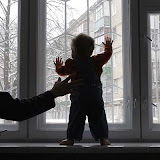The Wakamiya evacuee housing complex in Koriyama city forms a giant grid of pre-fab buildings, 11 apartments per building, 5 buildings per row, erected on a field of gravel and asphalt. In the middle is the Odagaisama Center—a community building with a recreation room and a radio station that broadcasts news and music to evacuees.
Fukushima evacuee radio station sites:
Koriyama
station homepage and livestream
Iwaki
station homepage and livestream
List of
other radio stations for evacuees.
(Note:
streaming doesn’t work in Safari.)
There is riotous laughter coming
out of Block G-1, Unit 2, of the Wakamiya temporary evacuee housing complex in
Koriyama. We hear it from the far end of the
row. As we approach, a small round man and a woman come erupting out the door.
As if the force of the laughter inside ejected them from the unit. They nearly
barrel into a neighbor, and as they relate a story, he is soon laughing too. I
smile politely and, still laughing, the couple introduce themselves.
Takaaki and Yumiko Ide are
evacuees from Kawauchi village. They are farmers, and one of the first things
Takaaki tells us is how he misses the trees that surround their farm in
the mountains near Namie. “And the vegetables, the vegetables,” his wife Yumiko
breaks in. “Here we have to buy food, for the first time in our lives!” Beans,
squash, rice and eggs, all from the store!
The Ides have lived here for 14
months with their family. Initially, five of them crowded into one 10 by 20-foot
unit, but as some other evacuees have left they’ve been able to spread out. Now
their teenage daughter lives on one side, and their two mothers on the other.
I ask if we could see what their
apartment looks like and soon we’re all pulling off shoes and crowding into the
small kitchen. The mothers, two little ladies, are sitting on stools behind a
table covered with steaming dishes. A round of introductions and soon the
laughter fills the room even more than the people.
Each unit has a traditional
tatami mat bedroom, a kitchenette and bathroom. Red Cross and government donations
provided them with a refrigerator, 2-burner stove, microwave, toaster oven,
washer and even a flat screen TV. It may feel small after their farm in the
hills. But compared to third-world refugee camps (or a Tokyo apartment) it’s
downright spacious.
The family is about to eat
dinner. Takaaki Ide, suddenly finding himself host to surprise visitors, both
wants and does not want us to stay. We refuse but as we trade phone numbers we
promise to return another day.
Outside, the sun has set but the
July heat still rises off the massive mall-sized parking lot in front of the Block
G-1 apartments. Every parking space is painted neatly with a letter and number:
evacuation planners intended for each family to bring exactly one car, but in
fact most of the lot is empty.
This complex
built after the quake has 570 units, housing evacuees from Tomioka, Kawauchi
and Futuba towns. All these towns are in the original 30-km exclusion zone, but
in some places the radiation levels have fallen. Kawauchi residents have
been allowed back in.
Like many
rural villages, Kawauchi’s population has been decreasing for a long time, down
to 2,800 in 2010 from 3,800 in 1995. (1) Now about 400 of them have returned
home full-time. (2) “The radiation level is down but there is no infrastructure
and no jobs and no place to work,” one volunteer, Beverly Tajima, told me.
Most
afternoons, after the shift ends at his new job in Koriyama, Takaaki Ide drives
back home to their farm. They were not permitted to bring their dog with them
to the temporary housing, and so he returns home to feed her. After one summer,
the weeds were taking over, he says. He cleared plants beside the house but
worried about radiation in the yard and left the rest standing.
One reason
for his optimism is that he is certain they’ll be able to move home eventually,
perhaps as soon as this fall. Japanese evacuees like those from Kawauchi have
something the Ukrainians don’t: hope.
Perhaps this
is an aspect of national character—Buddhist equanimity versus Slavic pessimism.
Or is it a function of timing? After two years, the future in Fukushima remains
uncertain, but give the Japanese two decades and they may be more like the Ukrainians,
resigned to their fate.
Tomorrow: more stories from evacuees
Sources:
(1) City Population
(2)
Bloomberg




